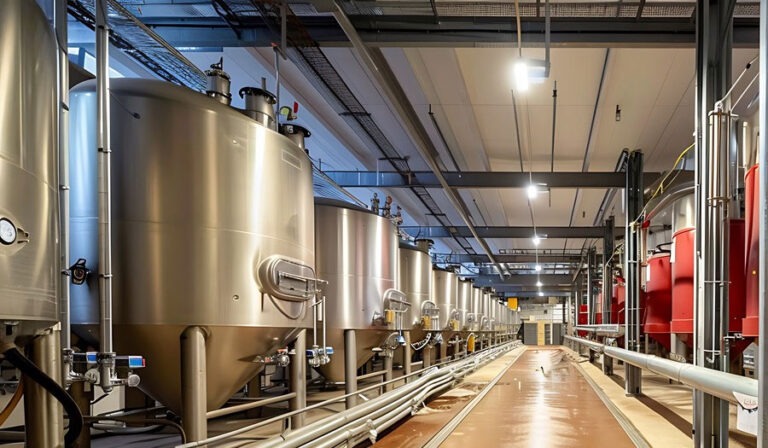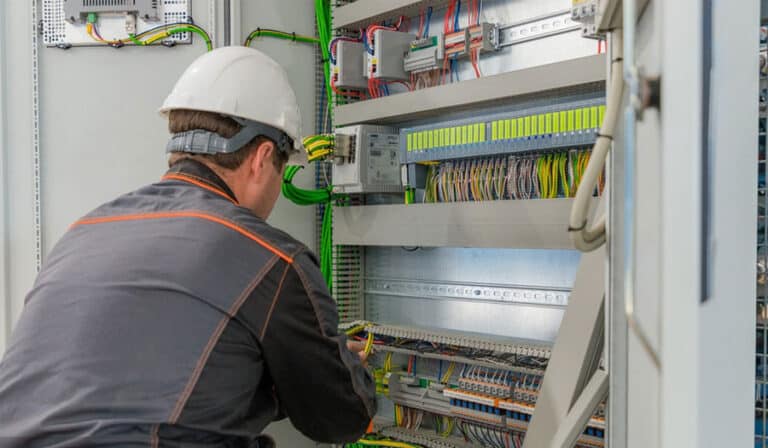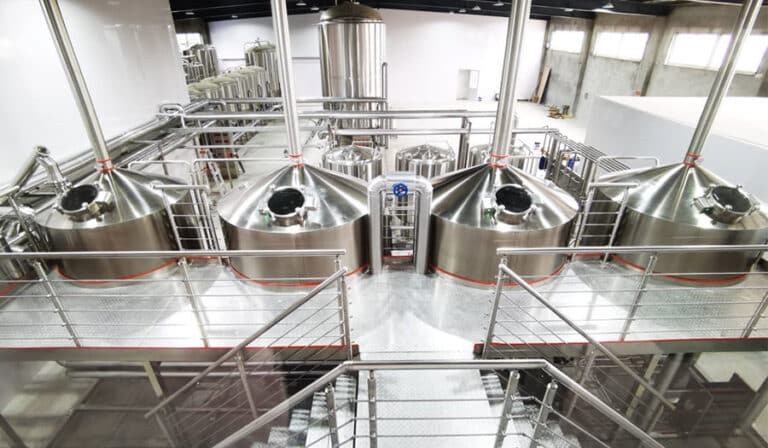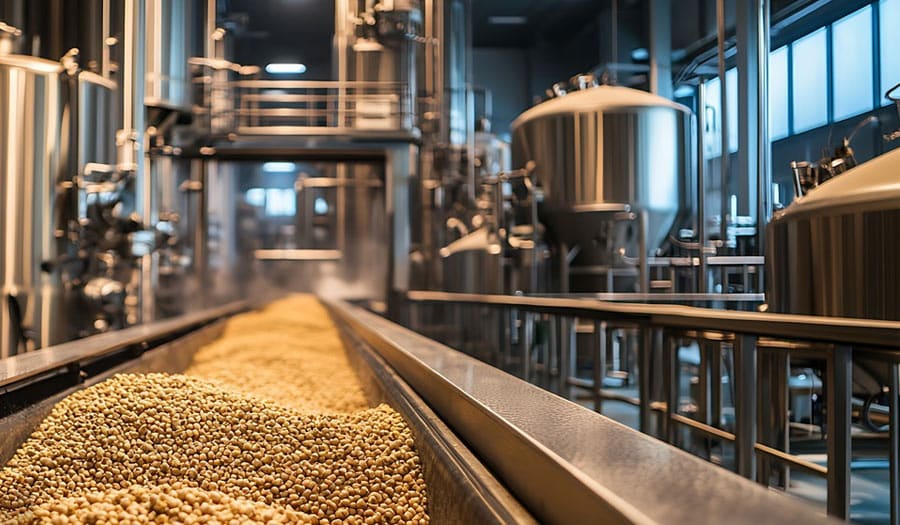As people’s demand for craft beer continues to increase, the craft beer production process has gradually been automated. Geautomatiseerde apparatuur not only improves production efficiency but also allows beer quality to be more finely controlled. In modern craft breweries, automated equipment is used in all links from raw material processing to fermentation and packaging. This equipment not only reduces the cost of manual operation but also enhances the stability and consistency of production.
Wat is een geautomatiseerde ambachtelijke brouwerij?
An automated craft brewery uses automation technology, intelligent control systems, and advanced equipment to manage and optimize the production process of craft beer. These breweries replace traditional manual labor with highly integrated automated equipment to achieve higher production efficiency, more precise quality control, and more consistent product taste while reducing human errors and improving production safety and traceability. In an automated craft brewery, many processes such as raw material handling, brewing, fermentation, and packaging are highly automated and no longer rely on human intervention. The entire production process is monitored and adjusted in real-time through computers and intelligent systems to ensure that each step is executed accurately, ensuring the high quality and consistency of the beer.

Components of an automated craft brewery
- Raw material preparation system: The raw material preparation stage of an automated craft brewery includes malt crushing, hops feeding, and water treatment. The equipment uses computer control to accurately adjust the input amount of each raw material to ensure the accuracy of the production process.
- Mashand boiling system: This is the core part of the brewing process. Automated mash pots, boiling pots, and other equipment can accurately control the temperature, time, and stirring speed to ensure that the sugar in the malt is completely dissolved and the aromatic components in the hops are effectively extracted.
- Cooling and fermentation system: After the mashand boiling process, the beer needs to be quickly cooled to a temperature suitable for fermentation. The automated cooling system can quickly cool down and maintain the temperature, pressure, and pH value in the fermentation tank through the temperature control system to ensure the stability of the fermentation process.
- Packaging system: The automated packaging line not only includes beer bottling and canning but also includes automatic labeling, detection, capping, and other functions. The entire packaging process does not require human intervention, which greatly improves the production speed and packaging accuracy.
- Central control system: All automated equipment is usually monitored and scheduled through a centralized control system. Through computers or cloud platforms, operators can remotely control equipment, view various real-time data during the production process, and adjust the production process.
Overview of automated craft brewery equipment
Malt grinder
The malt grinder is a key equipment in craft beer production. It is mainly used to grind malt particles into suitable particle sizes for enzymatic hydrolysis and sugar extraction in the subsequent mash process. The ground malt can increase its contact area with water, promote the dissolution of sugar in the malt, and thus provide fermentable sugars required for fermentation. The correct degree of grinding is crucial to the flavor, taste, and fermentation efficiency of beer.
Fermentation tank equipment
De fermentatietank is one of the core equipment in craft beer production and is mainly used in the fermentation stage of beer brewing. Fermentation is a key link in beer brewing. In this process, yeast converts sugar into alcohol and carbon dioxide and produces rich flavor substances, which determine the alcohol content, taste, aroma, and other characteristics of beer. The design, material, and operating conditions of the fermentation tank directly affect the fermentation effect and the final quality of beer.
The fermentation tanks in modern automated craft breweries are usually equipped with advanced monitoring systems that can track and adjust parameters such as temperature, pressure, pH value, liquid level, oxygen concentration, etc. in real time to ensure precise control of the fermentation process.
Automatic filling equipment
Automated packaging equipment makes beer production from bottling, and canning to packaging unmanned, reducing manual intervention and improving production efficiency. Automated bottling lines and canning lines can complete tasks such as filling, sealing, labeling, and packaging of beer. Each link is monitored and adjusted by sensors and control systems to ensure the hygiene standards and packaging consistency of beer.
PLC control system
PLC is a digital computer specially used for industrial automation control. It automatically performs various tasks through programmed control methods and monitors the operating status of the equipment in real-time. The basic principle of the PLC control system is to compile a control logic through programming, and output control signals after judging the input signals (such as sensor data, switch status, etc.) through program logic, and instruct the equipment to perform corresponding operations. For example, PLC can control the switch of brewing equipment, adjust the temperature, control the liquid level, start and stop the pump, etc.

Onderhoud van geautomatiseerde apparatuur voor ambachtelijke brouwerijen
Regular inspection and maintenance
For the equipment of automated craft breweries, regular inspection and maintenance are the basis for keeping the equipment in good condition. Check the wear of mechanical parts such as transmission systems, valves, and pipelines, and replace damaged parts in time to prevent equipment from malfunctioning. Regularly check control systems, sensors, PLC, and other electronic components to ensure the stability of signals and the accuracy of checking transmission faults. The maintenance of electronic components requires professional technicians to avoid misoperation or operation of the system.
Reiniging en desinfectie
The production process of beer has extremely high requirements for sanitary conditions, so the cleaning and disinfection of equipment is essential. Automated equipment is usually equipped with a CIP system for automatic cleaning of pipes and containers, but manual inspection and manual cleaning are still indispensable. The CIP system can automatically cycle and clean equipment such as fermentation tanks, mash pots, and equipment. The cooling cycle cleaning of each equipment should be adjusted according to the production situation to ensure the cleaning effect.
Troubleshooting and repair
Automated control systems are usually equipped with a fault alarm function, and maintenance personnel can diagnose the fault based on the alarm information. If the alarm system cannot provide enough information, maintenance personnel need to check one by one in combination with the historical data and operating status of the equipment.
Training and skills improvement
The technical level of maintenance personnel directly affects the quality and efficiency of equipment maintenance. Therefore, regular training and skills improvement are also important components of automated craft brewery equipment management. Through training, maintenance personnel can master the latest equipment technology, maintenance methods, and troubleshooting skills, and improve their ability to deal with equipment failures.
Advantages of Automated Craft Breweries
- Improve production efficiency: Automated craft breweries have greatly improved production efficiency through efficient operation of equipment and minimal manual intervention. The automation and intelligence of the production process have significantly improved the speed and reliability of the production line, allowing it to respond to market demand faster.
- Improve the consistency of product quality: The automated control system can accurately monitor the parameters of each production link to ensure the consistent quality of each batch of beer. This not only reduces the impact of human factors on quality but also increases consumer trust.
- Reduced production costs: Labor costs are reduced through automated systems, and efficient operation of equipment can reduce energy waste and raw material losses. In the long run, automated craft breweries can significantly reduce the overall cost of production.
- Better resource management: Automation equipment can monitor resource consumption in various production links in real-time, such as water, electricity, gas, etc., helping craft breweries to better manage resources, reduce waste, and improve the sustainability of production.
- Flexible production capacity: The automation system can flexibly adjust production plans and production volumes according to demand, thereby helping craft breweries cope with market fluctuations and diverse demands, and quickly launch different flavors and types of beer.
- Efficient maintenance management: The automation system can monitor the operating status of the equipment in real-time and provide fault warnings to help promptly detect equipment problems and take repair measures. This preventive maintenance reduces production pauses caused by equipment failure and further improves production reliability.

FAQ
How to determine the equipment maintenance frequency of automated craft breweries?
The maintenance frequency of equipment depends on the frequency of use and the type of equipment. Generally speaking, mechanical equipment such as pumps, crushers, brewing systems, etc. require regular daily inspection and lubrication, usually once a week or a month. For key equipment (such as temperature control systems, sensors, PLC systems, etc.), it is necessary to perform it once a quarter.
How to ensure the stability of automated equipment in long-term operation?
The key to ensuring the long-term stable operation of automated equipment is regular inspection and maintenance. By formulating a detailed plan, and regularly cleaning, lubricating, and testing the status of the equipment, the failure rate can be effectively reduced. In addition, automated craft breweries should also adopt an intelligent monitoring system to track the operating data of the equipment in real-time, and adjust the working parameters in time according to the feedback information to avoid excessive operation of the equipment or failure to meet the indicators.
How to extend the service life of automated brewing equipment?
The key to extending the life of automated brewing equipment is scientific maintenance. In addition to regular cleaning and lubrication, operators should also keep the equipment running within the normal load range to avoid overload operations. For electronic equipment such as sensors and PLC, regular adjustments and maintenance inspections should be carried out to ensure the accuracy of the signal. Finally, the cooling system of the equipment should be regularly maintained to prevent damage caused by overheating.
Does the equipment of the automated craft brewery require manual intervention?
Although the equipment of the automated craft brewery can be operated automatically to a large extent, manual intervention is still required to handle emergencies, adjust production processes, perform equipment maintenance, and conduct quality inspections. Manual intervention is usually to ensure the normal operation of the equipment and the flexibility of production. Regular manual inspections, analysis of production data, and process adjustments are still important links in maintaining stable production.




